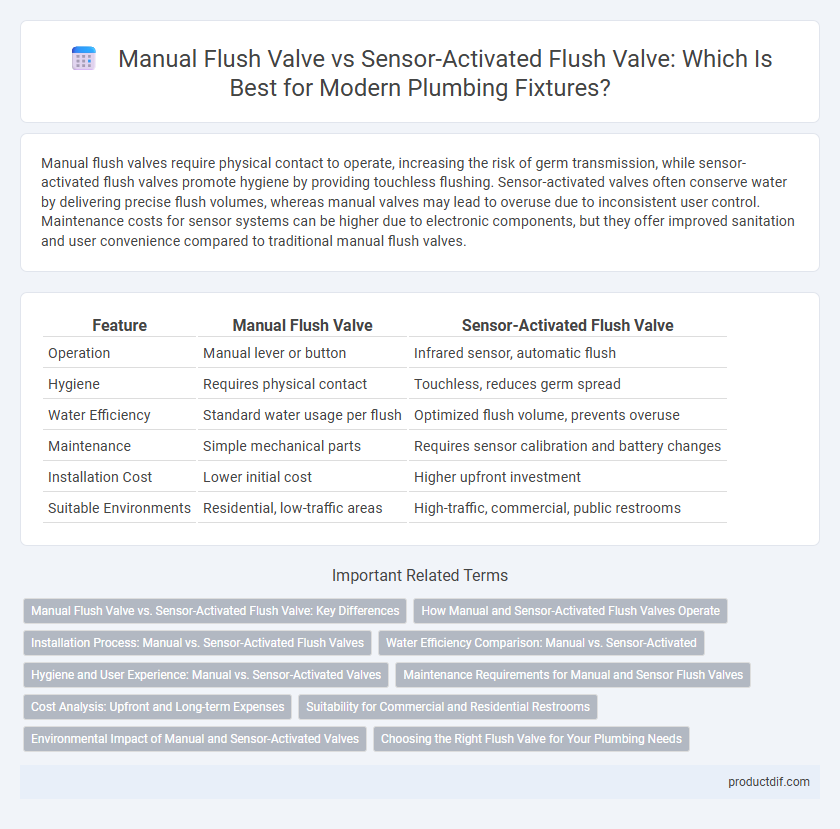Manual flush valves require physical contact to operate, increasing the risk of germ transmission, while sensor-activated flush valves promote hygiene by providing touchless flushing. Sensor-activated valves often conserve water by delivering precise flush volumes, whereas manual valves may lead to overuse due to inconsistent user control. Maintenance costs for sensor systems can be higher due to electronic components, but they offer improved sanitation and user convenience compared to traditional manual flush valves.
Table of Comparison
| Feature | Manual Flush Valve | Sensor-Activated Flush Valve |
|---|---|---|
| Operation | Manual lever or button | Infrared sensor, automatic flush |
| Hygiene | Requires physical contact | Touchless, reduces germ spread |
| Water Efficiency | Standard water usage per flush | Optimized flush volume, prevents overuse |
| Maintenance | Simple mechanical parts | Requires sensor calibration and battery changes |
| Installation Cost | Lower initial cost | Higher upfront investment |
| Suitable Environments | Residential, low-traffic areas | High-traffic, commercial, public restrooms |
Manual Flush Valve vs. Sensor-Activated Flush Valve: Key Differences
Manual flush valves require physical contact to operate, making them more prone to wear and potential hygiene concerns due to repeated touching, while sensor-activated flush valves use infrared technology to detect user presence, promoting hands-free operation and enhanced sanitation. Sensor-activated valves often contribute to water conservation by regulating flush volume based on user detection, whereas manual valves typically deliver a fixed water volume with each flush. Maintenance for sensor-activated valves can be more complex and costly due to electronic components, unlike manual flush valves, which are generally simpler to repair and install.
How Manual and Sensor-Activated Flush Valves Operate
Manual flush valves operate by requiring a user to physically press a handle or button to release water, providing straightforward control over flushing. Sensor-activated flush valves use infrared or capacitive sensors to detect user presence, automatically triggering the flush without physical contact. These mechanisms enhance hygiene and water efficiency by ensuring flush activation only when necessary.
Installation Process: Manual vs. Sensor-Activated Flush Valves
Manual flush valves typically have a straightforward installation process involving direct water line connections and simple mechanical components, requiring minimal electrical work. Sensor-activated flush valves demand more complex installation, including electrical wiring, sensor calibration, and power source integration, which may necessitate a professional plumber or electrician. The choice affects installation time, technical skill requirements, and potential maintenance considerations in commercial or residential plumbing fixtures.
Water Efficiency Comparison: Manual vs. Sensor-Activated
Sensor-activated flush valves significantly reduce water waste by delivering precise flush volumes based on usage frequency, whereas manual flush valves often lead to over-flushing due to inconsistent user operation. Studies show sensor-activated systems can save up to 30% more water annually compared to manual valves, enhancing overall water efficiency in commercial and public restrooms. Implementing sensor technology aligns with sustainability goals and reduces utility costs by optimizing water consumption during each flush cycle.
Hygiene and User Experience: Manual vs. Sensor-Activated Valves
Sensor-activated flush valves significantly enhance hygiene by minimizing contact with surfaces, reducing the spread of germs compared to manual flush valves that require physical touch. User experience improves with sensor-activated systems due to their hands-free operation, promoting convenience and accessibility for all users. Manual flush valves may offer simplicity and lower initial costs but lag behind in sanitation and ease of use in public and high-traffic restrooms.
Maintenance Requirements for Manual and Sensor Flush Valves
Manual flush valves require regular inspection and cleaning to prevent buildup of debris and ensure the handle mechanism operates smoothly, with occasional replacement of washers and seals to avoid leaks. Sensor-activated flush valves demand more specialized maintenance due to electronic components, including battery replacement or power supply checks and sensor calibration to maintain accurate detection and flushing. Both types benefit from routine maintenance to extend lifespan and optimize performance, but sensor valves typically incur higher maintenance costs due to their complex technology.
Cost Analysis: Upfront and Long-term Expenses
Manual flush valves have lower upfront costs, making them a budget-friendly choice for initial installation. Sensor-activated flush valves involve higher initial investment due to advanced technology and installation requirements but offer long-term savings by reducing water consumption and maintenance expenses. Over time, sensor-activated valves can lead to lower total costs through efficiency and reduced labor for repairs and cleaning.
Suitability for Commercial and Residential Restrooms
Manual flush valves are widely used in both commercial and residential restrooms due to their simplicity, cost-effectiveness, and ease of maintenance. Sensor-activated flush valves offer enhanced hygiene and water efficiency, making them ideal for high-traffic commercial restrooms where touchless operation reduces germ transmission. While sensor-activated valves provide convenience and sanitation benefits, manual valves remain preferred in residential settings where installation costs and battery maintenance may be concerns.
Environmental Impact of Manual and Sensor-Activated Valves
Manual flush valves typically consume more water due to inconsistent user activation, leading to higher water waste compared to sensor-activated flush valves. Sensor-activated flush valves use infrared technology to control water flow precisely, reducing water usage by up to 30% and minimizing environmental impact. The reduction in water waste from sensor-activated systems contributes to lower energy and resource consumption associated with water treatment and distribution.
Choosing the Right Flush Valve for Your Plumbing Needs
Manual flush valves offer reliable control and are typically more cost-effective for budget-conscious plumbing installations, making them ideal for areas with low maintenance capacity. Sensor-activated flush valves enhance hygiene by minimizing touchpoints, reducing the spread of germs, and are well-suited for high-traffic public restrooms prioritizing hands-free operation. Evaluating factors such as user convenience, water efficiency, maintenance requirements, and budget constraints ensures selection of the optimal flush valve to meet specific plumbing needs.
manual flush valve vs sensor-activated flush valve Infographic

 productdif.com
productdif.com